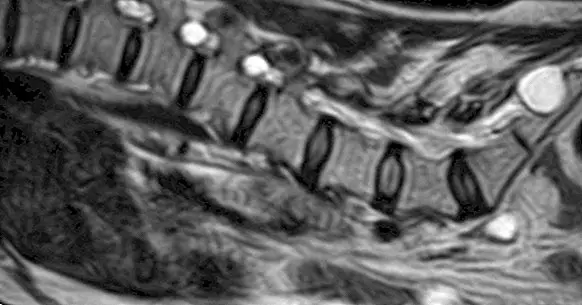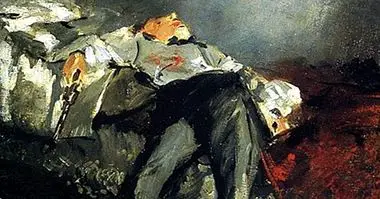Tarlov cysts: symptoms, causes and treatment
Occasionally and due to certain types of organic anomalies, our body produces and develops a series of abnormal masses formed by membranous pockets that house substances or liquid elements produced by the body itself. Although in most cases do not pose a danger to the physical integrity of the person, its effects can be quite annoying. This is the case of Tarlov cysts , abnormal formations that may appear in the lumbar or sacral area.
Throughout this article we will discuss the characteristics of these malformations, as well as the symptoms associated with them, their causes and possible treatments.
- Related article: "Meninges: anatomy, parts and functions in the brain"
What are Tarlov cysts?
Diagnosed also under the label of perineural, periradicular or extradural arachnoid cysts , Tarlov cysts are bodies of small dimensions and inside which contain a small amount of cerebrospinal fluid.
These cysts are formed by dilation of the dura mater, so they are classified as a pathology of this. These are anomalous formations that also have a stem or prolongation that keeps them connected to the spinal subarachnoid space , also located around the nerves of the sacral and lumbar areas which are pressed or compressed by these cysts.
Although, as just mentioned, Tarlov cysts usually affect the nerves located in the lower area of the spine, these abnormal bodies are completely asymptomatic in the first phase of their development. That is, they do not have to lead to the appearance of symptoms that give them away.
However, in cases in which the person suffers some traumatism or inflammation, or when the compression of the nerves is very serious, the patient may experience pains in the lumbar areas. As well as symptoms of sciatica, urinary incontinence or headaches among many others that will be cited in the next point.
These pathological formations of the dura, which They are named after the American neurosurgeon Isadore Tarlov , they have much more incidence in women and their symptoms can be reduced by means of a diet or alkaline diet, among many other treatments.
What is the symptomatology?
The main characteristic of Tarlov cysts is that they are usually asymptomatic, at least in 70% of the people who suffer from them. However, in the rest of the cases they can be highly annoying.
Due to the discretion with which they are developed, in most cases they are accidentally discovered when the person undergoes some type of neuroimaging test such as a nuclear magnetic resonance and tend to be evaluated as formations without any kind of pathological importance.
In some cases, during the first stages of their formation, symptoms may appear that develop either gradually or, on the contrary, may appear a painful clinical picture , suddenly. Likewise, the severity or intensity with which the symptoms affect the person will depend to a large extent on the size at which the Tarlov cysts develop.
In most patients, the symptoms begin with a slight pain experienced at the same level as the cyst is , followed by a series of alterations in all those organs or functions related to the nerve on which the pressure is exerted.
Although initially they do not pose a threat or danger to the physical health of the person, without effective treatment, Tarlov cysts can lead to very severe complications that seriously compromise the quality of life of the patient, which is susceptible to develop any type of physical or partial disability or complete disability.
Among the main symptoms that can manifest themselves are:
- Pain in the lumbar area or sabra.
- Sciatic pain .
- Pain at the level of the buttocks.
- Pain in the hip.
- Muscle pain in the thighs due to a decrease in blood flow.
- Complications in the excretory organs.
- Alterations in the reproductive organs.
- Decrease in sensitivity or hypesthesia.
- Tingling sensation or paresthesia.
As a consequence, people suffering from Tarlov cysts they experience great difficulties in carrying out certain movements or postures such as standing or trying to sit. In the same way, to bow or lie down can be a great torment due to the painful feelings they cause.
What causes does it have?
At the moment, it has not been possible to establish a completely reliable cause of Tarlov cysts.However, over time, different theories have been developed whose main hypotheses relate these cysts to a traumatic, congenital and hemorrhagic origin.
1. Congenital hypothesis
This first theory points to the idea that certain irregularities in the formation of the membranes that surround the brain known as meninges may be the main cause of the formation of these cysts; O well a congenital alteration in the most superficial of these membranes , the dura mater;
2. Traumatic hypothesis
On the other hand, the traumatic hypothesis describes that the lesions caused by spinal punctures, anesthesia applied in the epidural area or in the spinal area, as well as traumas that affect the sacral area they can also be the origin of the appearance of these cerebrospinal fluid masses.
3. Hemorrhagic hypothesis
As the name suggests, the hemorrhagic hypothesis is based on the assumption that the cyst is produced by a subarachnoid hemorrhage .
How can it be diagnosed?
As pointed out above, in most cases the Tarlov cysts they are usually diagnosed accidentally when the person undergoes some type of neuroimaging test made in the area where the masses are located.
However, in cases where the person begins to experience the first symptoms it will be necessary to perform a functional magnetic resonance . In addition, in order to rule out the possibility that it is any other type of condition, a computerized myelography should be performed that reveals a connection between the cyst and the subarachnoid space.
Is there a treatment?
The choice of one of the possible treatments for Tarlov cysts is subject to the type of effects and symptoms experienced by the patient, as well as the size of the cyst and the results of physical tests.
In smaller cysts that do not cause very large or bothersome symptoms, it is usually resorted to intervention by physiotherapy, combined with the administration of anti-inflammatory medication or analgesic. Recent studies have revealed that gabapentin, traditionally used for the treatment of epilepsy and neuropathic pain, is highly effective in reducing the effects of cysts.
However, in those cases of greater severity, it is very possible that the patient must undergo an intervention through surgery. By a technique known as fenestration, the surgeon can perforate the cyst and drain the cerebrospinal fluid which is inside. Then proceed to seal it to avoid the possibility of the liquid to replenish it.
Finally, a treatment that has been quite effective in alleviating the pain of Tarlov cysts is transcutaneous electrical nerve stimulation. An intervention that has no side effects and that involves the application of small electric currents through the skin.



















